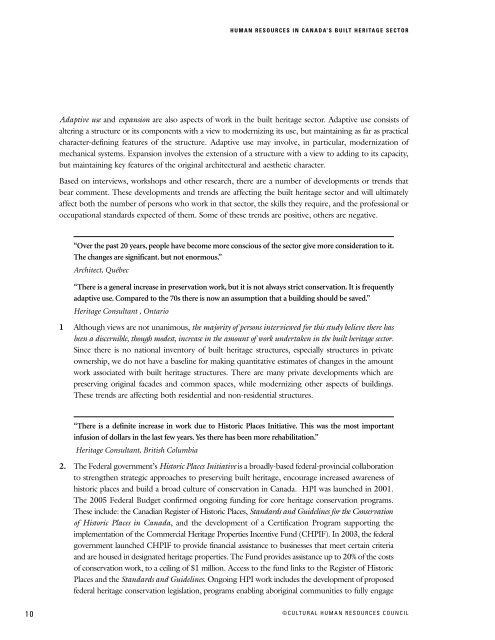Human Resources in Canada's Built Heritage Sector: Mapping the ...
Human Resources in Canada's Built Heritage Sector: Mapping the ...
Human Resources in Canada's Built Heritage Sector: Mapping the ...
- No tags were found...
You also want an ePaper? Increase the reach of your titles
YUMPU automatically turns print PDFs into web optimized ePapers that Google loves.
HUMAN RESOURCES IN CANADA’S BUILT HERITAGE SECTORAdaptive use and expansion are also aspects of work <strong>in</strong> <strong>the</strong> built heritage sector. Adaptive use consists ofalter<strong>in</strong>g a structure or its components with a view to moderniz<strong>in</strong>g its use, but ma<strong>in</strong>ta<strong>in</strong><strong>in</strong>g as far as practicalcharacter-def<strong>in</strong><strong>in</strong>g features of <strong>the</strong> structure. Adaptive use may <strong>in</strong>volve, <strong>in</strong> particular, modernization ofmechanical systems. Expansion <strong>in</strong>volves <strong>the</strong> extension of a structure with a view to add<strong>in</strong>g to its capacity,but ma<strong>in</strong>ta<strong>in</strong><strong>in</strong>g key features of <strong>the</strong> orig<strong>in</strong>al architectural and aes<strong>the</strong>tic character.Based on <strong>in</strong>terviews, workshops and o<strong>the</strong>r research, <strong>the</strong>re are a number of developments or trends thatbear comment. These developments and trends are affect<strong>in</strong>g <strong>the</strong> built heritage sector and will ultimatelyaffect both <strong>the</strong> number of persons who work <strong>in</strong> that sector, <strong>the</strong> skills <strong>the</strong>y require, and <strong>the</strong> professional oroccupational standards expected of <strong>the</strong>m. Some of <strong>the</strong>se trends are positive, o<strong>the</strong>rs are negative.“Over <strong>the</strong> past 20 years, people have become more conscious of <strong>the</strong> sector give more consideration to it.The changes are significant. but not enormous.”Architect, Québec“There is a general <strong>in</strong>crease <strong>in</strong> preservation work, but it is not always strict conservation. It is frequentlyadaptive use. Compared to <strong>the</strong> 70s <strong>the</strong>re is now an assumption that a build<strong>in</strong>g should be saved.”<strong>Heritage</strong> Consultant , Ontario1 Although views are not unanimous, <strong>the</strong> majority of persons <strong>in</strong>terviewed for this study believe <strong>the</strong>re hasbeen a discernible, though modest, <strong>in</strong>crease <strong>in</strong> <strong>the</strong> amount of work undertaken <strong>in</strong> <strong>the</strong> built heritage sector.S<strong>in</strong>ce <strong>the</strong>re is no national <strong>in</strong>ventory of built heritage structures, especially structures <strong>in</strong> privateownership, we do not have a basel<strong>in</strong>e for mak<strong>in</strong>g quantitative estimates of changes <strong>in</strong> <strong>the</strong> amountwork associated with built heritage structures. There are many private developments which arepreserv<strong>in</strong>g orig<strong>in</strong>al facades and common spaces, while moderniz<strong>in</strong>g o<strong>the</strong>r aspects of build<strong>in</strong>gs.These trends are affect<strong>in</strong>g both residential and non-residential structures.“There is a def<strong>in</strong>ite <strong>in</strong>crease <strong>in</strong> work due to Historic Places Initiative. This was <strong>the</strong> most important<strong>in</strong>fusion of dollars <strong>in</strong> <strong>the</strong> last few years. Yes <strong>the</strong>re has been more rehabilitation.”<strong>Heritage</strong> Consultant, British Columbia2. The Federal government’s Historic Places Initiative is a broadly-based federal-prov<strong>in</strong>cial collaborationto streng<strong>the</strong>n strategic approaches to preserv<strong>in</strong>g built heritage, encourage <strong>in</strong>creased awareness ofhistoric places and build a broad culture of conservation <strong>in</strong> Canada. HPI was launched <strong>in</strong> 2001.The 2005 Federal Budget confirmed ongo<strong>in</strong>g fund<strong>in</strong>g for core heritage conservation programs.These <strong>in</strong>clude: <strong>the</strong> Canadian Register of Historic Places, Standards and Guidel<strong>in</strong>es for <strong>the</strong> Conservationof Historic Places <strong>in</strong> Canada, and <strong>the</strong> development of a Certification Program support<strong>in</strong>g <strong>the</strong>implementation of <strong>the</strong> Commercial <strong>Heritage</strong> Properties Incentive Fund (CHPIF). In 2003, <strong>the</strong> federalgovernment launched CHPIF to provide f<strong>in</strong>ancial assistance to bus<strong>in</strong>esses that meet certa<strong>in</strong> criteriaand are housed <strong>in</strong> designated heritage properties. The Fund provides assistance up to 20% of <strong>the</strong> costsof conservation work, to a ceil<strong>in</strong>g of $1 million. Access to <strong>the</strong> fund l<strong>in</strong>ks to <strong>the</strong> Register of HistoricPlaces and <strong>the</strong> Standards and Guidel<strong>in</strong>es. Ongo<strong>in</strong>g HPI work <strong>in</strong>cludes <strong>the</strong> development of proposedfederal heritage conservation legislation, programs enabl<strong>in</strong>g aborig<strong>in</strong>al communities to fully engage10©CULTURAL HUMAN RESOURCES COUNCIL










